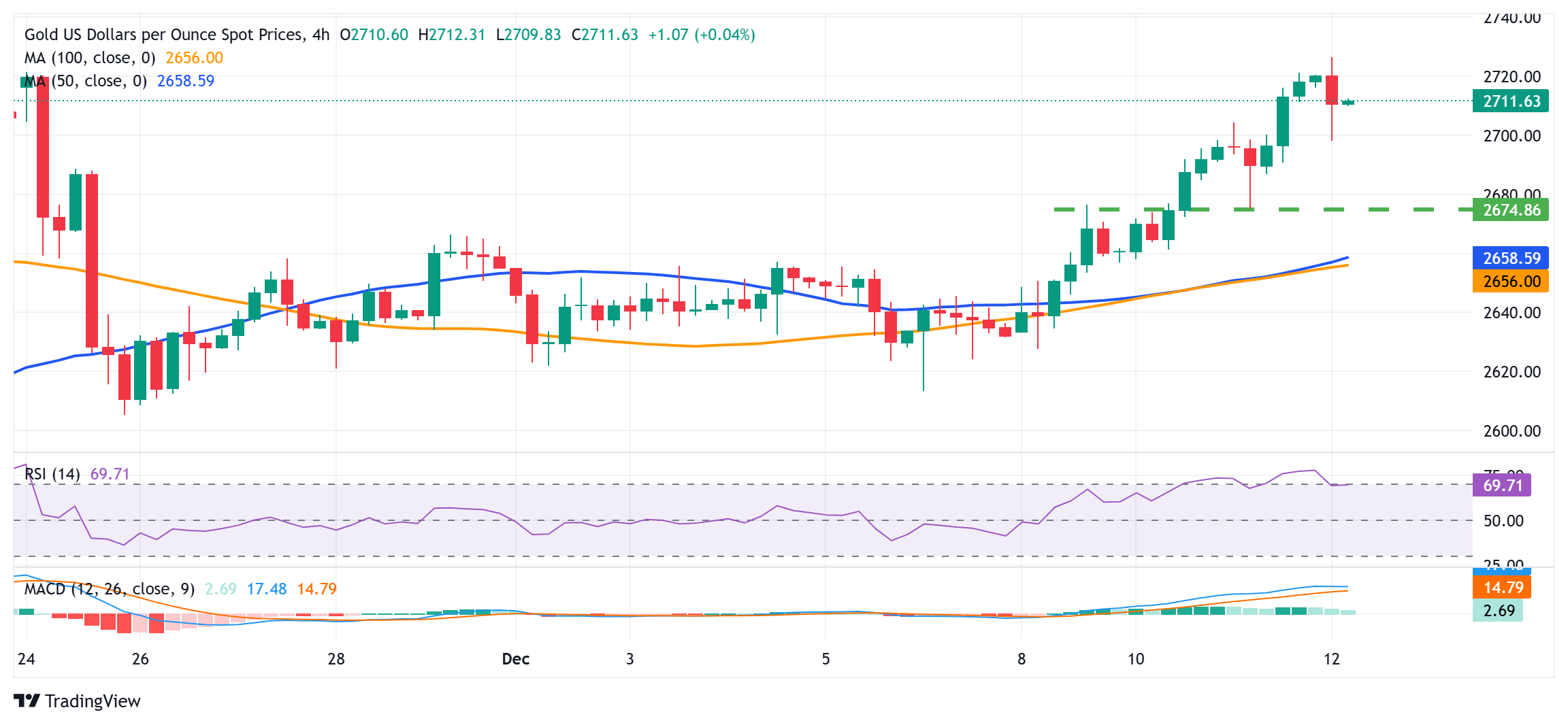- Gold price witnesses an intraday turnaround from over a one-month top touched on Thursday.
- Bet for a less dovish Fed and rising US bond yields undermine the non-yielding yellow metal.
- Geopolitical risks, trade war fears and December Fed rate cut bets lend support to the XAU/USD.
Gold price (XAU/USD) reverses an Asian session dip to sub-$2,700 levels, though it remains below the highest level in more than a month touched earlier this Thursday. The US consumer inflation data released on Wednesday reaffirmed bets that the Federal Reserve (Fed) will deliver a third consecutive interest rate cut next week. Apart from this, persistent geopolitical risks stemming from the Russia-Ukraine war and conflicts in the Middle East, along with concerns about US President-elect Donald Trump's impending trade tariffs, continue to act as a tailwind for the safe-haven precious metal.
Meanwhile, investors now seem convinced that the Fed will adopt a cautious stance on cutting interest rates amid signs that the progress in lowering inflation toward its 2% target has virtually stalled. This leads to a further rise in the US Treasury bond yields, which acts as a tailwind for the US Dollar (USD) and keeps a lid on any further gains for the non-yielding Gold price. Nevertheless, the aforementioned fundamental backdrop suggests that any corrective pullback might still be seen as a buying opportunity. Traders now look to the US Producer Price Index (PPI) for a fresh impetus.
Gold price attracts some dip-buyers amid safe-haven demand, bets for another Fed rate cut in December
- The release of the mostly in-line US consumer inflation figures on Wednesday reinforced market expectations that the Federal Reserve will lower borrowing costs again at its upcoming policy meeting next week.
- The US Bureau of Labor Statistics (BLS) reported that the headline Consumer Price Index rose 0.3% in November, marking the largest gain since April, and the yearly rate edged up to 2.7% from 2.6% in October.
- Additional details revealed that the core gauge, which excludes volatile food and energy prices, increased 0.3% during the reported month and was up 3.3% as compared to the same time period last year.
- According to the CME Group's FedWatch Tool, the likelihood of another 25-basis points rate cut by the Fed on December 18 shot to more than 98%, pushing the Gold price to over a one-month high on Thursday.
- The lifts the yield on the benchmark climbs to a two-week high amid expectation that US President-elect Donald Trump's policies will boost inflationary pressures and force the Fed to pause its rate-cutting cycle.
- This, in turn, assists the US Dollar to preserve its recent strong gains to a fresh monthly top, which, along with the prevalent risk-on environment, prompts some profit-taking around the non-yielding yellow metal.
- Meanwhile, geopolitical risk premium remains in play amid the worsening Russia-Ukraine war and the ongoing conflicts in the Middle East. Moreover, trade war fears should help limit losses for the XAU/USD.
- Traders now look to Thursday's US economic docket – featuring the release of the US Producer Price Index and the usual Weekly Initial Jobless Claims data – for some impetus later during the North American session.
- The focus, however, will remain glued to the highly anticipated FOMC monetary policy meeting next week, which will play a key role in determining the next leg of a directional move for the non-yielding commodity.
Gold price bulls might wait for a move beyond the $2,720-2,722 hurdle before placing fresh bets
From a technical perspective, the Relative Strength Index (RSI) on hourly charts has eased from slightly overbought conditions. Furthermore, oscillators on the daily chart have just started gaining positive traction, which, in turn, supports prospects for the emergence of some dip-buying around the Gold price. Hence, any further weakness below the $2,700 mark might continue to find some support near the overnight swing low, around the $2,675-2,674 area. Some follow-through selling, however, could pave the way for further losses towards the $2,658-2,656 confluence – comprising 50- and 200-period Simple Moving Averages (SMAs) on the 4-hour chart.
On the flip side, the Asian session high, around the $2,726 area, now seems to act as an immediate hurdle, above which the Gold price could aim to surpass the $2,735 barrier and test the $2,748-2,750 supply zone. A sustained strength beyond the latter will set the stage for a move towards challenging the all-time peak, around the $2,800 neighborhood touched in October, with some intermediate resistance near the $2,775 region.
Interest rates FAQs
Interest rates are charged by financial institutions on loans to borrowers and are paid as interest to savers and depositors. They are influenced by base lending rates, which are set by central banks in response to changes in the economy. Central banks normally have a mandate to ensure price stability, which in most cases means targeting a core inflation rate of around 2%. If inflation falls below target the central bank may cut base lending rates, with a view to stimulating lending and boosting the economy. If inflation rises substantially above 2% it normally results in the central bank raising base lending rates in an attempt to lower inflation.
Higher interest rates generally help strengthen a country’s currency as they make it a more attractive place for global investors to park their money.
Higher interest rates overall weigh on the price of Gold because they increase the opportunity cost of holding Gold instead of investing in an interest-bearing asset or placing cash in the bank. If interest rates are high that usually pushes up the price of the US Dollar (USD), and since Gold is priced in Dollars, this has the effect of lowering the price of Gold.
The Fed funds rate is the overnight rate at which US banks lend to each other. It is the oft-quoted headline rate set by the Federal Reserve at its FOMC meetings. It is set as a range, for example 4.75%-5.00%, though the upper limit (in that case 5.00%) is the quoted figure. Market expectations for future Fed funds rate are tracked by the CME FedWatch tool, which shapes how many financial markets behave in anticipation of future Federal Reserve monetary policy decisions.
Information on these pages contains forward-looking statements that involve risks and uncertainties. Markets and instruments profiled on this page are for informational purposes only and should not in any way come across as a recommendation to buy or sell in these assets. You should do your own thorough research before making any investment decisions. FXStreet does not in any way guarantee that this information is free from mistakes, errors, or material misstatements. It also does not guarantee that this information is of a timely nature. Investing in Open Markets involves a great deal of risk, including the loss of all or a portion of your investment, as well as emotional distress. All risks, losses and costs associated with investing, including total loss of principal, are your responsibility. The views and opinions expressed in this article are those of the authors and do not necessarily reflect the official policy or position of FXStreet nor its advertisers. The author will not be held responsible for information that is found at the end of links posted on this page.
If not otherwise explicitly mentioned in the body of the article, at the time of writing, the author has no position in any stock mentioned in this article and no business relationship with any company mentioned. The author has not received compensation for writing this article, other than from FXStreet.
FXStreet and the author do not provide personalized recommendations. The author makes no representations as to the accuracy, completeness, or suitability of this information. FXStreet and the author will not be liable for any errors, omissions or any losses, injuries or damages arising from this information and its display or use. Errors and omissions excepted.
The author and FXStreet are not registered investment advisors and nothing in this article is intended to be investment advice.
Recommended content
Editors’ Picks

EUR/USD sticks to gains near 1.0500 ahead of ECB policy announcements
EUR/USD holds positive bias near 1.0500 in the European session on Thursday amid a broad US Dollar retreat. However, the upside remains capped amid expectations for more ECB rate cuts in 2025. ECB policy announcements and Lagarde's press conference are on tap.

GBP/USD rebounds toward 1.2800 as US Dollar retreats
GBP/USD recovers its recent losses and heads toward 1.2800 in the European morning on Thursday. The pair bounces as the US Dollar corrects downwards after breaking its four-day winning streak despite higher US Treasury yields. Focus shifts to US PPI and Jobless Claims data.

Gold price reverses intraday dip to $2,700; flat lines amid mixed fundamental cues
Gold price reverses an Asian session dip to sub-$2,700 levels, though it remains below the highest level in more than a month touched earlier this Thursday. The US consumer inflation data released on Wednesday reaffirmed bets that the Federal Reserve will deliver a third consecutive interest rate cut next week.

Sui hits new all-time high of $4.9 as Backpack integration sparks $466 million DEX volume surge
Sui price reaches a new all-time high of $4.9 on Thursday after increasing more than 20% the previous week. The main reason behind the rally is Wednesday’s announcement of the Backpack exchange and wallet integration with the SUI blockchain and decentralized exchange volume reaching new highs.

BTC faces setback from Microsoft’s rejection
Bitcoin price hovers around $98,400 on Wednesday after declining 4.47% since Monday. Microsoft shareholders rejected the proposal to add Bitcoin to the company’s balance sheet on Tuesday.

Best Forex Brokers with Low Spreads
VERIFIED Low spreads are crucial for reducing trading costs. Explore top Forex brokers offering competitive spreads and high leverage. Compare options for EUR/USD, GBP/USD, USD/JPY, and Gold.
